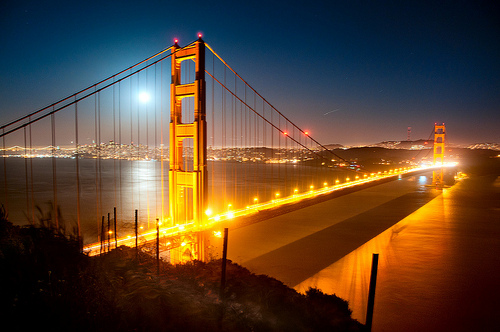Capturing a dynamic range that includes detail in both the moon and the night landscape is essentially an unsolvable problem. The moon is as bright as daylight and the the night is as dark as night. So even if you create a bracketed sequence that covers this roughly 20EV light-to-dark spread you’ll come up with an image that looks unrealistic to people. Photo-compositing in the moon is even worse: unless you are very careful and unless you get the astronomy right it simply looks fake.

When the problem is unsolvable, the answer is usually to compromise. With this image of the moon rising behind the Golden Gate Bridge I bracketed for HDR in a short dynamic range. The image is comprised of three exposures, shot at five seconds, ten seconds, and twenty seconds. I used a tripod and an 18mm focal length, setting the ISO to 200 and the aperture to f/6.3. I processed the images by hand in Adobe Camera RAW and Photoshop, and partially blended in a layer created from the three exposures in Nik HDR Efex Pro.
In no respect does the image capture the entire dynamic range between the moon and the dark night landscape in the foreground and to the right. But there is far more suggestion of color and details across the dynamic range than there would have been in any single shot.
Pingback: Multi-Raw Processing Fort Point and the Golden Gate Bridge
Jean zSimpson
5 Dec 2023Love the composition of this!!!